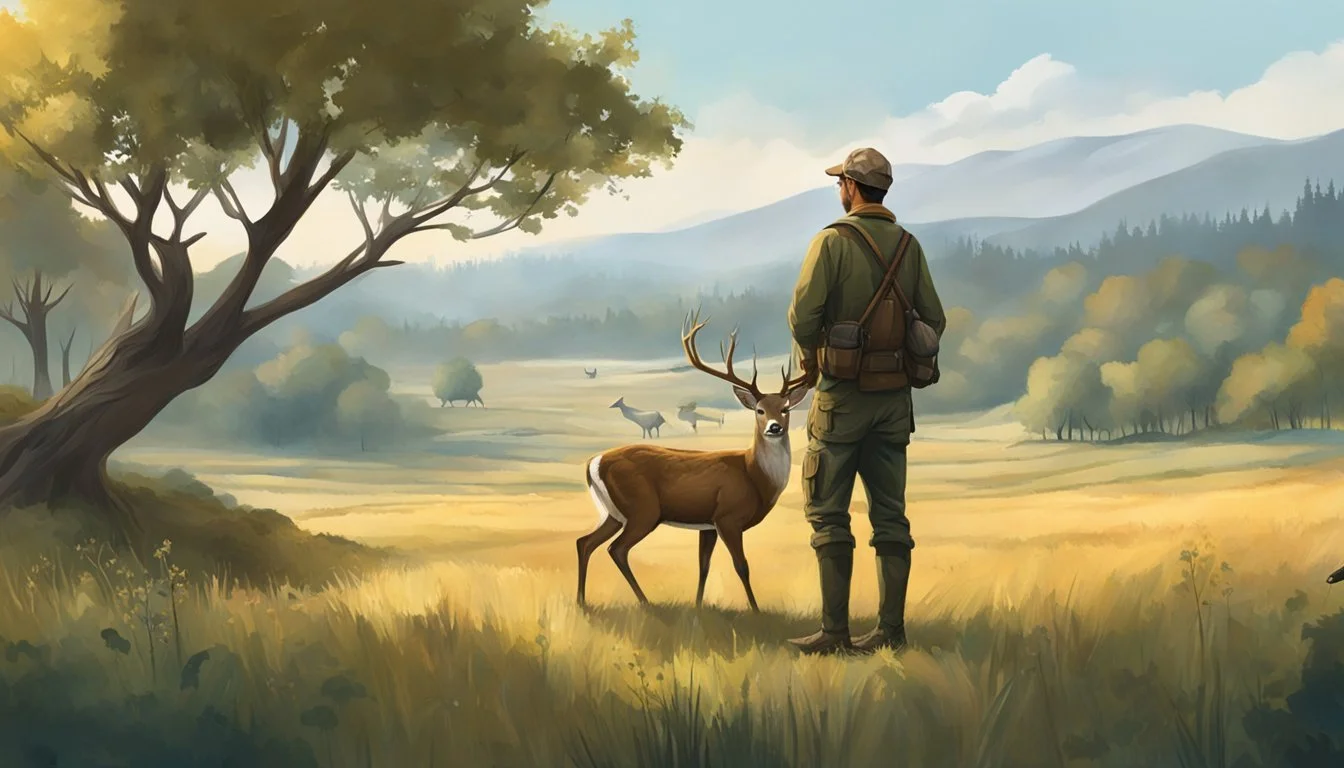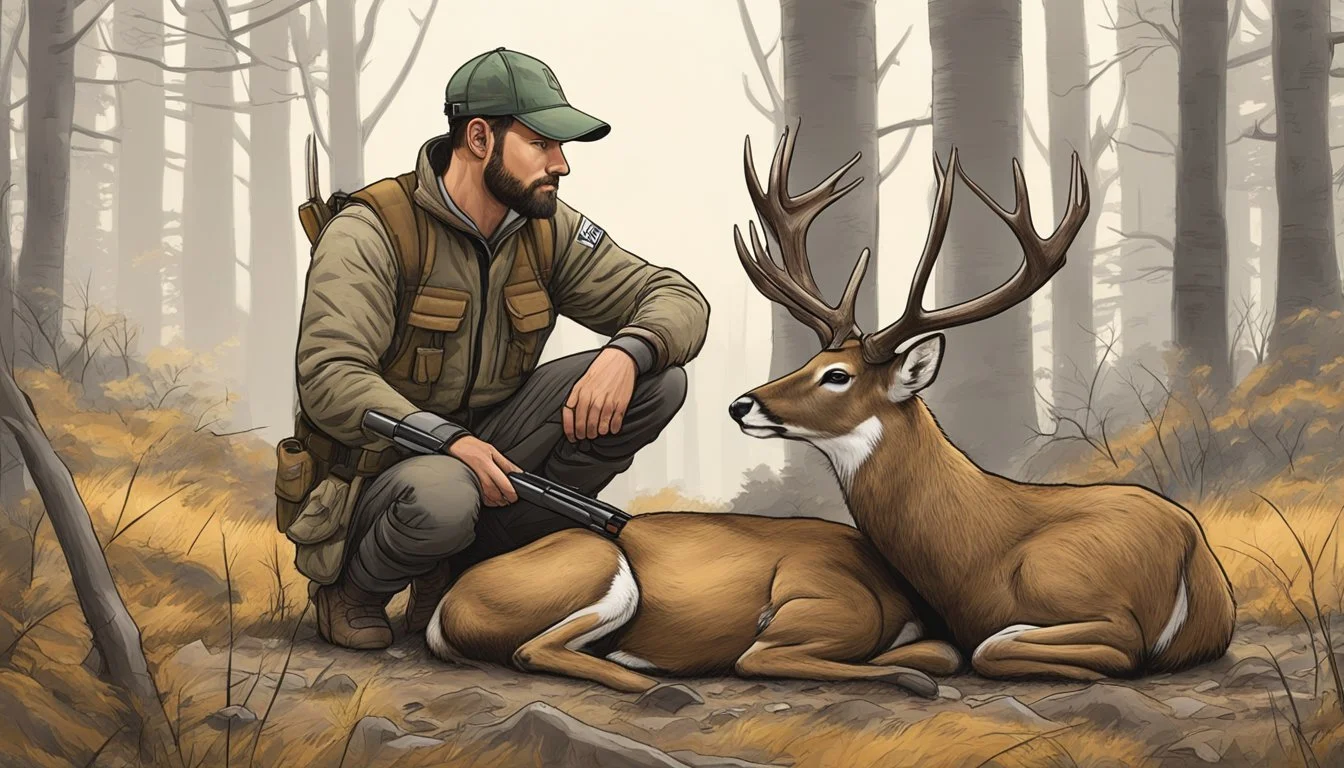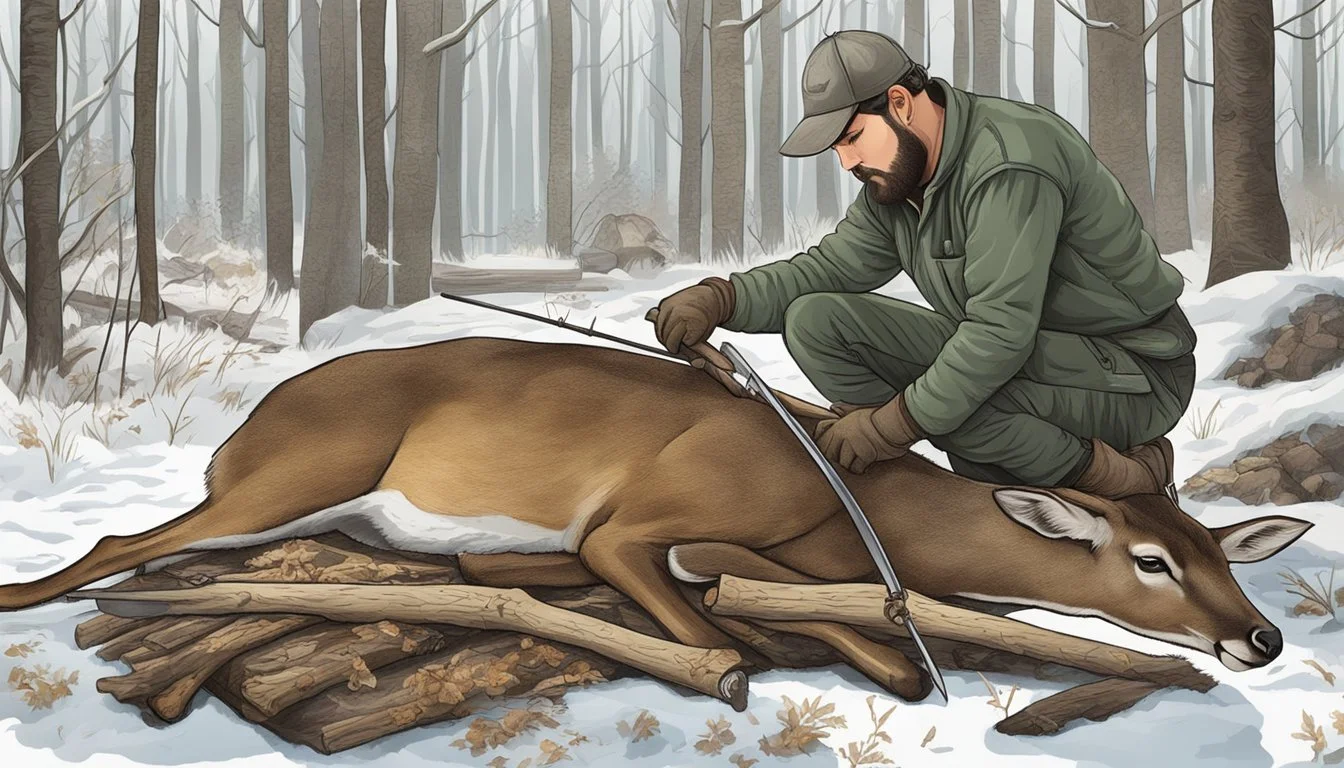Field Dressing a Deer
Essential Steps for Quick and Efficient Processing
Discover > Hunting for Dummies > Field Dressing a Deer
To field dress a deer is an essential skill for hunters to master. It ensures the quality and safety of the venison (What wine goes well with venison?) they harvest. The process involves removing the internal organs to prevent spoilage and contamination and this makes the carcass lighter and easier to transport. A successful field dress hinges on proper technique, cleanliness, and timing, as delays or mistakes may compromise the meat's taste and edibility.
For those new to hunting or looking to hone their skills, this article will provide a step-by-step account to field dress a deer. The information discussed here is based on best practices and safety measures, which will help prevent the spread of disease or bacterial contamination. Furthermore, it also aims to educate readers on the importance of how to field dress a deer and how it relates to ethical hunting practices.
Before delving into the specifics of the field dress, it is crucial to understand its role in the larger context of hunting and conservation. Quickly and efficiently cleaning a deer benefits both the hunter and the environment, as it minimizes waste and preserves the quality of the meat from the carcass. Consequently, honing this skill ultimately leads to a more rewarding hunting experience and even a deeper appreciation for the outdoors.
Understanding the Importance of Field Dressing
A field dress is a crucial skill for any hunter to master. It is the process of removing the internal organs of the deer from the chest cavity to preserve the quality of its meat and reduce the risk of contamination. When a hunter quickly and successfully dresses a deer in the field, he significantly improves the chances of a successful hunt.
The primary goal of the field dress is to cool the carcass down quickly. After death, deer like any warm-blooded mammals, have residual body heat that starts breaking down the meat immediately. By promptly removing the internal organs, a hunter allows the body heat to escape, ensuring that the meat remains fresh and healthy to eat.
It is essential to avoid puncturing the intestines or stomach during the field dress process. A single puncture with a knife blade can release bacteria and fluids, spoiling the meat and wasting the efforts put into the hunt. Effective field dressing techniques minimize the risk of such accidents.
Finally, field dressing makes transporting the deer back to camp or home much more manageable. A deer carcass without its internal organs is significantly lighter and easier to carry. Given that some hunts may take place far from roads or vehicles, easy transportation of the carcass is a crucial benefit.
Preparation Before the Field Dress
Before starting the field dressing process, gathering the necessary tools and ensuring that everything is ready for efficient and safe deer processing is essential. A very sharp knife is crucial for clean and precise cuts. A dull knife can lead to mistakes, wasted meat, and accidents where you cut yourself. A high-quality knife with a sturdy and non-slip grip is recommended. Always carry a sharpener and make sure your knife is properly sharpened.
Gloves, particularly latex gloves, are useful in maintaining cleanliness and protecting the user from potential infection. They'll make the process more manageable and ensure proper hygiene when handling the deer. Wearing gloves is highly recommended, especially for those with sensitive skin or open wounds.
A strong rope is needed to secure the deer in an optimal position for field dressing. Make sure the rope is strong enough to handle the weight of the deer and long enough to secure it to a nearby tree or other support.
In some cases, a small saw may be required for cutting parts of the deer, such as the pelvic bone. A compact and lightweight saw designed for field dressing is recommended, for easy packing and to make the procedure quick and efficient.
Lastly, it's important to have a game tag readily available. Once the deer has been field dressed, it's crucial to tag it quickly and correctly. Always follow relevant hunting laws and regulations to ensure legal possession and transport of the deer.
Step by Step Account in Field Dressing a Deer
Laying the Deer
Before starting the field dressing process, lay the deer on its back with its hind legs spread apart. This allows for easy access to the body cavity and organs. Raise the back legs using a branch or log to create better access.
Making the First Incision
Using your blade, make a small incision at the base of the sternum. Avoid cutting too deep to prevent puncturing the intestines. Cut carefully and continue to cut down towards the genitals, cutting around them. Carefully cut around the anus and the sex organs, and watch carefully to make sure not to puncture the bladder or large intestine, as this could contaminate the meat. If the deer is a doe, remove the udder, while if it's a buck, remove the scrotum, testicles, and penis.
Split the pelvis and pelvic bone by sawing through it. You can buy a steel tool, a game splitter, simplifying the pelvis splitting.
Removing the Entrails
Return to the top of the incision and continue cutting to free the lower organs from the pelvic cavity, and using the fingers of one hand, pull them out along with the stomach and large intestine. As you remove the guts with your fingers, there shouldn't be much blood, but still be cautious not to puncture the stomach or intestines, as this could contaminate the meat. Once the gut has been removed, set it aside.
Severing the Diaphragm and Windpipe
Next, sever the diaphragm, which is the thin muscle separating the chest cavity from the abdominal cavity. When the diaphragm muscle is removed, locate the heart and lungs. Cut through the connective tissue holding them in place, and slice through the esophagus. This will leave the heart, lungs, and windpipe hanging so you can grab them and remove them together. Place the heart and lungs with the lower organs.
Final Steps in Field Dressing
With all the organs removed, the body cavity should be empty. Rinse the cavity with clean water, removing any remaining blood, tissue, or debris, and prop it open with a stick to help air circulate, cooling and drying the carcass. Avoid dragging the deer, as this can introduce dirt and contaminants into the body cavity. Ensure proper storage and transportation of the field-dressed deer to maintain the quality of the meat.
Post Field Dressing Processes
Checking for Meat Quality
After dressing a deer in the field, it's essential to assess the quality of the meat. Carefully inspect the carcass for any bruising, parasites, or abnormal color. Quality venison should be uniform in color and free of any visible contamination. Remember that proper handling during the field-dressing process helps maintain the quality of the meat.
Transporting the Deer
Once the meat quality has been checked, it's time to transport the deer. Attach a rope to the deer's neck or antlers, and use the terrain to your advantage. When dragging the carcass, avoid sharp objects, logging debris, or obstacles that may damage the meat. Use a game cart or ATV to make transportation more manageable if available.
Preparing for the Processing
Before sending the deer to a meat processor, take the time to prepare the carcass. Skinning the deer ensures that the hide and fur are removed, making it easier for the processor to handle and refrigerate the meat. Using strong rope or straps, hang the carcass from a tree or a sturdy support. Ensure the rope is strong enough to take the weight of the deer. Start by making a careful skin hole on the front and hind legs with your knife and working your way towards the head from the legs1.
Understanding the Role of a Taxidermist
If preserving the head, skin, or other parts of the deer for display, a taxidermist should be consulted on the details. Taxidermists are skilled professionals who specialize in the art of preserving and mounting animal specimens. They have the necessary knowledge and tools to handle the delicate process of removing hair, fur, and other tissues while maintaining skin integrity. Be sure to consult with a reputable taxidermist for the best results.




